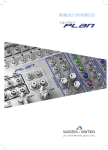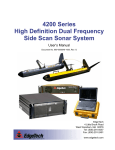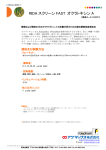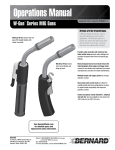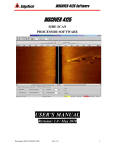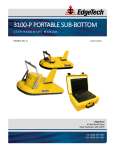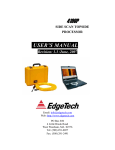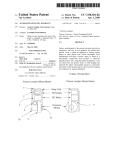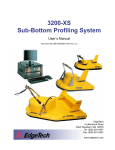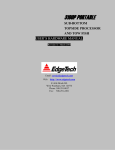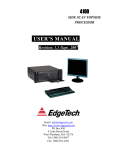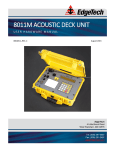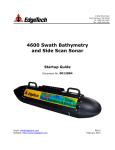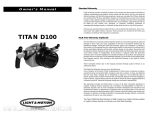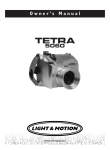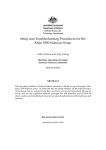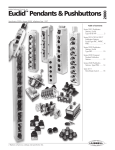Download 4125 Dual Frequency Side Scan Sonar System Rev D (lo res)
Transcript
4125 Series Dual Frequency Side Scan Sonar System User’s Manual Document No. 990-4125MAN-1000 Rev. D EdgeTech 4 Little Brook Road West Wareham, MA 02576 Tel: (508) 291-0057 Fax: (508) 291-2491 www.edgetech.com ii The information, figures and specifications in this manual are proprietary and are issued in strict confidence on condition that they not be copied, reprinted or disclosed to a third party either wholly or in part without the prior written consent of EdgeTech. Any reproduction of EdgeTech supplied software or file sharing is strictly prohibited. © Copyright 2012 by EdgeTech. All rights reserved. Full SpectrumTM is a trademark of EdgeTech. Microsoft® and Windows XP® are registered trademarks of Microsoft Corporation. Kevlar® is a registered trademarks of the DuPont Company. Intel® and Pentium® are registered trademarks of Intel Corporation. Novagard G624® is a trademark of Novagard Solutions, Inc. CentrinoTM is a trademark of Intel Corporation. Kellems® is a registered trademark of Hubbell Incorporated. Storm CaseTM is a trademark Pelican, Inc. 4125 Dual Frequency Side Scan Sonar System User’s Manual Document No. 990-4125MAN-1000 Rev. D iii Warning—Read This First! All personnel involved with the installation, operation or maintenance of the equipment described in this manual should read and understand the warnings and recommendations provided below. Operation in Air Do not allow the transducer arrays on the tow vehicle to continuously transmit in air for an extended period as damage to the transducer arrays could occur. Static Sensitive Devices This equipment contains devices that are extremely sensitive to static electrical charges. Therefore extreme care should be taken when handling them as static electricity may be present on the body and clothing. Normal handling precautions involve the use of anti-static protection materials and grounding straps for personnel. Radiation This equipment generates, uses and can radiate radio frequency energy. Therefore if the equipment is not installed properly, it may cause interference with radio communications. The equipment has not been tested for compliance with the appropriate FCC rules designed to provide reasonable protection against such interference when operated in a commercial environment. Therefore when operating the equipment in a residential area, the user may be required to take whatever measures are needed and incur any expenses necessary to eliminate interference; it is the user's responsibility to verify that the system complies with the applicable FCC emission limits. High Voltages High voltages that can cause injury or death are present in the tow vehicle and the topside processor. Always use caution when removing the electronics from these devices. Improper Line Voltage Operation with improper line voltage may cause serious damage to the equipment. Always ensure that the proper line voltage is used. iv Hardware Variations and Compatibility The 4125 Series Dual Frequency Side Scan Sonar System contains both standard PC and proprietary hardware. At times EdgeTech may change the standard components due to their availability or performance improvements. Although the component manufacturers and their models and styles may change from unit to unit, replacement components will generally be interchangeable. EdgeTech will make every effort to see that replacement printed circuit boards are interchangeable and that they use the same software drivers. At times, however, there may be instances where direct replacements do not exist. When this happens, EdgeTech will provide the necessary drivers with the replacement board. Chassis styles may also vary due to availability and manufacturer model changes. This situation could result in different board placement and cable routings. Therefore all cable routing and part location drawings in this manual should be used as a guide. In addition to cabling, the position and style of controls and indicators may change with different available chassis styles. However, their presence and function will remain the same. Additional controls and indicators may also be added for specials and options. 4125 Dual Frequency Side Scan Sonar System User’s Manual Document No. 990-4125MAN-1000 Rev. D v Preface We, the employees at EdgeTech, would like to thank you for purchasing a 4125 Series Dual Frequency Side Scan Sonar System. At EdgeTech it is our policy to provide high quality, cost effective products and support services that meet or exceed your requirements, to deliver them on time and to continuously look for ways to improve them. We take pride in the products we manufacture and want you to be entirely satisfied with your equipment. The information in this manual will get you started. It tells you what you need to set up, to operate and to maintain the 4125 Series Dual Frequency Side Scan Sonar System. Purpose of this Manual The purpose of this manual is to provide the user with information on the setup, operation, care, and maintenance of the EdgeTech 4125 Series Dual Frequency Side Scan Sonar System. Although this manual encompasses the latest operational features of the 4125 Series Dual Frequency Side Scan Sonar System, some features of the system may be periodically upgraded. Therefore the information in this manual is subject to change and should be used for reference only. This manual is divided into the following five sections and three appendices: Section 1: Overview. Provides some background information about EdgeTech and describes the main components of the 4125 Series Dual Frequency Side Scan Sonar System and the available optional equipment. Section 2: Specifications. Lists the electrical, mechanical and environmental specifications for the main components of the 4125 Series Dual Frequency Side Scan Sonar System. Section 3: Setup, Test and Deployment. Provides instructions on how to set up and test the 4125 Series Dual Frequency Side Scan Sonar System and how to deploy and tow the tow vehicle. Section 4: Technical Description. Provides a general description of the hardware elements comprising the main components of the 4125 Series Dual Frequency Side Scan Sonar System. Section 5: Maintenance and Troubleshooting. Provides some maintenance recommendations and instructions on how to disassemble and reassemble the 4125 Tow Vehicle and calibrate the compass. Included also are some troubleshooting procedures. vi Appendix A: Printer Connections. Lists many of the printers that can be used with the 4125 Series Dual Frequency Side Scan Sonar System and provides the setup requirements and general specifications for a few of these printers that will provide the best results. Appendix B: System Backup and Restore. Provides instructions on how to backup and restore the hard drive on the topside processors that use one. Appendix C: 4125 Towing Characteristics. Provides graphical plots representing the towing characteristics of the 4125 Tow Vehicle for various cable lengths, tow vehicle speeds and tow vehicle depths. Warnings, Cautions and Notes Where applicable, warnings, cautions and notes are provided in this manual as follows: WARNING! Identifies a potential hazard that could cause personal injury or death to yourself or to others. CAUTION! Identifies a potential hazard that could be damaging to equipment or could result in the loss of data. NOTE: Recommendations or general information that is particular to the material being presented or a referral to another part of this manual or to another manual. Liability EdgeTech has made every effort to document in this manual the 4125 Series Dual Frequency Side Scan Sonar System accurately and completely. However, EdgeTech assumes no liability for errors or for any damages that result from the use of this manual or the equipment it documents. EdgeTech reserves the right to upgrade features of this equipment and to make changes to this manual without notice at any time. 4125 Dual Frequency Side Scan Sonar System User’s Manual Document No. 990-4125MAN-1000 Rev. D vii Warranty All equipment manufactured by EdgeTech is warranted against defective components and workmanship for a period of one year after shipment. Warranty repair will be done by EdgeTech free of charge. Shipping costs are to be borne by the customer. Malfunction due to improper use is not covered in the warranty and EdgeTech disclaims any liability for consequential damage resulting from defects in the performance of the equipment. No product is warranted as being fit for a particular purpose and there is no warranty of merchantability. This warranty applies only if: i. The items are used solely under the operating conditions and in the manner recommended in Seller's instruction manual, specifications, or other literature. ii. The items have not been misused or abused in any manner or repairs attempted thereon. Unless prior authorization from Edgetech customer Service iii. Written notice of the failure within the warranty period is forwarded to Seller and the directions received for properly identifying items returned under warranty are followed. iv. The return notice authorizes Seller to examine and disassemble returned products to the extent Seller deems necessary to ascertain the cause for failure. The warranties expressed herein are exclusive. There are no other warranties, either expressed or implied, beyond those set forth herein, and Seller does not assume any other obligation or liability in connection with the sale or use of said products. Any product or service repaired under this warranty shall be warranted for the remaining portion of the original warranty period only. Equipment not manufactured by EdgeTech is supported only to the extent of the original manufacturer's warranties. viii Software Service Agreement EdgeTech provides software services free of charge for one year following the purchase of an EdgeTech system. A Software Service Agreement (SSA), which is available for an annual fee, covers these services after the first year. The services are listed below. The SSA does not address customer specified modifications or enhancements. These services may be ordered separately. Furthermore, EdgeTech software upgrades are meant for the sole use of EdgeTech customers that have purchased a system within a year or have an existing SSA. Any reproduction of EdgeTech supplied software or file sharing is strictly prohibited. Software Updates and Enhancements EdgeTech customers can download new software releases with all modifications and enhancements along with user's manual changes from the EdgeTech ftp site. Major software issues, should they occur, will be reported directly to the customer. New software releases consist of the following: · Software enhancements that are not on the price list · Software fixes and changes · Product integration · Documentation updates to on-line help · Tests for compatibility with other modules Software patches consist of software that has undergone the following: · Minor software enhancements · Software fixes and changes Software Performance Report EdgeTech customers may submit reports using a Software Performance Report (SPR) form. SPR forms are available from EdgeTech. This report may be related to a problem or to an inquiry, or it may be a specific request for a software enhancement. EdgeTech will attend to the SPR at a priority level appropriate to the seriousness of the problem and to the availability of a work-around. 4125 Dual Frequency Side Scan Sonar System User’s Manual Document No. 990-4125MAN-1000 Rev. D ix Software Telephone, Facsimile and E-mail Support The SSA entitles EdgeTech customers to contact EdgeTech Customer Service by telephone, facsimile or e-mail to report a difficulty, to discuss a problem or to receive advice on the best way to perform a task. When contacted, EdgeTech Customer Service will do the following: · Respond within 24 hours · Immediately attend to serious problems affecting operations · Attempt to find an immediate work-around Software Service Agreement Fee The SSA covers one year and is renewable upon expiration. For the SSA annual fee, please contact EdgeTech Customer Service directly. For contact information refer to Customer Service. x Returned Material Authorization Prior to returning any equipment to EdgeTech a Returned Material Authorization (RMA) number must be obtained. The RMA will help us identify your equipment when it arrives at our receiving dock and track the equipment while it is at our facility. The material should be shipped to the address provided in Customer Service. Please refer to the RMA number on all documents and correspondence as well. All returned material must be shipped prepaid. Freight collect shipments will not be accepted. NOTE: The case supplied with the 4125-P Portable Topside Processor is based on the Pelican Storm Case series. This case is not a shipping crate. Please use appropriate packaging material to ensure protection of the processor case when shipping or contact Edgetech Customer Service for recommended crates. The following steps apply only to material being returned from outside the Continental United States. Follow them carefully to prevent delays and additional costs. 1. All shipments must be accompanied by three copies of your proforma invoice, showing the value of the material and the reason for its return, if the reason is for repair, it must be clearly stated in order to come through customs faster and without duties being charged. Whenever possible, please send copies of original export shipping documents with the consignment. 2. If the value of the equipment is over $1000, the following Shipper's oath must be sent with the invoice. This oath can be typed on the invoice, or on a separate letterhead. "I, ______________________________, declare that the articles herein specified are the growth, produce, or manufacture of the United States; that they were exported from the United States from the port of _____________________, on or about _______________; that they are returned without having been advanced in value or improved in condition by any process of manufacture or any other means; and that no drawback, or allowance has been paid or admitted hereof." Signed ______________________________ 3. If there is more than one item per consignment, a packing list must accompany the shipment. It is acceptable to combine the proforma invoice and packing list as long as the contents of each carton are clearly numbered and identified on the invoice. 4125 Dual Frequency Side Scan Sonar System User’s Manual Document No. 990-4125MAN-1000 Rev. D xi 4. Small items can be shipped prepaid directly to EdgeTech by FedEx, DHL, UPS, Airborne, etc. 5. If the equipment is the property of EdgeTech (formerly EG&G Marine Instruments Division) please insure for full value. 6. Fax one invoice, packing list, and a copy of the airway bill to EdgeTech upon shipment. Customer Service Customer service personnel at EdgeTech are always eager to hear from users of our products. Your feedback is welcome and is a valuable source of information which we use to continually improve these products. Therefore we encourage you to contact customer service to offer any suggestions or to request technical support. They can be reached as follows: E-mail: [email protected] Mail: 4 Little Brook Road West Wareham, MA 02576 Telephone: (508) 291-0057, Ext 712 Facsimile: (508) 291-2491 For more information please go to www.edgetech.com. xii Table of Contents Warning—Read This First!................................................................................ iii Operation in Air ............................................................................................. iii Static Sensitive Devices ................................................................................ iii Radiation ....................................................................................................... iii High Voltages................................................................................................ iii Improper Line Voltage ................................................................................... iii Hardware Variations and Compatibility ............................................................. iv Preface .............................................................................................................. v Purpose of this Manual................................................................................... v Warnings, Cautions and Notes ...................................................................... vi Liability .......................................................................................................... vi Warranty .......................................................................................................... vii Software Service Agreement .......................................................................... viii Software Updates and Enhancements ........................................................ viii Software Performance Report ..................................................................... viii Software Telephone, Facsimile and E-mail Support ...................................... ix Software Service Agreement Fee .................................................................. ix Returned Material Authorization ........................................................................ x Customer Service ............................................................................................. xi Table of Contents ............................................................................................ xii List of Figures .................................................................................................. xv List of Tables ..................................................................................................xvii SECTION 1: OVERVIEW ................................................... 1-1 1.1 1.2 1.3 1.3.1 1.3.2 1.3.3 1.4 1.4.1 1.4.2 1.4.3 1.4.4 Company Background ......................................................................1-1 4125 Series Applications ..................................................................1-2 Main System Components ................................................................1-3 4125-P Portable Topside Processor ..............................................1-3 Tow Vehicle...................................................................................1-3 Tow Cable .....................................................................................1-5 Optional Equipment ..........................................................................1-6 Additional Telemetry......................................................................1-6 Depressor Wing Kit .......................................................................1-6 Keel Weight ...................................................................................1-7 HullScan W/O and W/ Telemetry Kits ............................................1-7 4125 Dual Frequency Side Scan Sonar System User’s Manual Document No. 990-4125MAN-1000 Rev. D xiii SECTION 2: SPECIFICATIONS ........................................... 2-1 2.1 2.2 2.3 4125-P Portable Topside Processor................................................. 2-1 4125 Tow Vehicle ............................................................................ 2-3 Cables ............................................................................................. 2-6 SECTION 3: SETUP, TEST AND DEPLOYMENT ................... 3-1 3.1 3.2 3.2.1 3.2.2 3.3 3.4 3.5 3.6 3.7 3.8 3.9 3.9.1 3.9.2 3.10 3.10.1 3.10.2 3.10.3 3.10.4 3.11 3.12 Unpacking and Inspection ................................................................ 3-1 Power Requirements........................................................................ 3-2 Use of an Uninterruptable Power Supply ...................................... 3-2 Changing to a Non-US Power Plug .............................................. 3-2 Navigation Interface ......................................................................... 3-2 Locating the 4125-P Portable Topside Processor ............................ 3-3 4125-P Portable Topside Processor Controls and Indicators ........... 3-3 4125-P Portable Topside Processor Connections ............................ 3-5 TCP/IP Address Settings ................................................................. 3-6 Assembling the 4125 Tow Vehicle ................................................... 3-7 Connecting the System Components ............................................... 3-8 Connecting and Attaching the Tow Cable to the Tow Vehicle ....... 3-9 Connecting the 4125-P Portable Topside Processor .................. 3-10 System Activation and Test ............................................................ 3-11 Preparing a Wired Ethernet LAN Connection.............................. 3-11 Preparing a Wireless Ethernet LAN Connection ......................... 3-12 Activating the 4125 Series Dual Frequency Side Scan Sonar System ....................................................................................... 3-12 Performing the Pre-deployment Checks ..................................... 3-13 Tow Vehicle Deployment ............................................................... 3-14 Tow Vehicle Recovery ................................................................... 3-16 SECTION 4: TECHNICAL DESCRIPTION ............................. 4-1 SECTION 5: MAINTENANCE AND TROUBLESHOOTING ........ 5-1 5.1 5.1.1 5.1.2 5.1.3 5.1.4 Periodic Maintenance....................................................................... 5-1 Cleaning the 4125-P Portable Topside Processor ........................ 5-1 Inspecting and Cleaning the Tow Vehicle and the Tow Cable after Use ....................................................................................... 5-1 Inspecting and Cleaning the Underwater Connectors ................... 5-2 Rearming the Tow Vehicle ............................................................ 5-2 xiv 5.2 5.3 5.3.1 5.3.2 5.4 5.5 5.6 5.7 5.8 5.8.1 5.8.2 5.8.3 5.8.4 5.9 5.10 Restoring the Operating System to the Hard Drive ...........................5-3 Disassembling and Reassembling a Tow Vehicle .............................5-3 Disassembling the Tow Vehicle .....................................................5-3 Reassembling the Tow Vehicle .....................................................5-6 Calibrating the Compass...................................................................5-7 General Troubleshooting ................................................................5-12 4125-P Portable Topside Processor Troubleshooting Guide ...........5-12 4125 Tow Vehicle Troubleshooting Guide.......................................5-13 Tow Cable Inspection .....................................................................5-14 Locating a Shorted Conductor .....................................................5-15 Locating an Open Conductor .......................................................5-15 Locating a Resistance Breakdown ..............................................5-16 Damaged Tow cable Connector ..................................................5-16 Part Numbers for Major 4125-P Portable Topside Processor Components ...................................................................................5-17 Part Numbers for Major 4125 Tow Vehicle Components.................5-18 APPENDIX A: Printer Connections .............................. A-1 A.1 A.2 EPC Model 1086NT ......................................................................... A-2 EPC Model HSP-100 ....................................................................... A-2 APPENDIX B: System Backup and Restore ................ B-1 B.1 B.2 Backing up the System Drive ........................................................... B-1 Restoring the System Drive ............................................................. B-7 APPENDIX C: 4125 Towing Characteristics ................ C-1 4125 Dual Frequency Side Scan Sonar System User’s Manual Document No. 990-4125MAN-1000 Rev. D xv List of Figures Figure 1-1: 4125 Series Dual Frequency Side Scan Sonar System being Readied for Deployment............................................................................................................ 1-2 Figure 1-2: 4125 Tow Vehicle, 4125-P Portable Topside Processor and Tow Cable ................ 1-4 Figure 1-3: Depressor Wing ..................................................................................................... 1-6 Figure 2-1: Kevlar Reinforced Tow Cable................................................................................. 2-7 Figure 2-2: Kevlar Reinforced Tow Cable, Telemetry ............................................................... 2-8 Figure 2-3: AC Power Cable .................................................................................................... 2-9 Figure 2-4: DC Power Cable .................................................................................................. 2-10 Figure 2-5: Ethernet Cable ..................................................................................................... 2-11 Figure 3-1: 4125-P Portable Topside Processor Side Panel .................................................... 3-4 Figure 3-2: 4125 Tow Vehicle Tail Fins Assembly .................................................................... 3-7 Figure 3-3: AC Power, DC Power and Ethernet Cables ........................................................... 3-8 Figure 3-4: Tow Vehicle with Tow Cable Connected and Attached .......................................... 3-9 Figure 3-5: DISCOVER 4125 Towfish Control Tab................................................................. 3-13 Figure 3-6: 4125 Tow Vehicle being Deployed ....................................................................... 3-15 Figure 3-7: Bottom Track Tab ................................................................................................ 3-16 Figure 4-1: 4125 Series Dual Frequency Side Scan Sonar System Overall Block Diagram ................................................................................................................. 4-2 Figure 4-2: 4125-P Portable Topside Processor Wiring Diagram ............................................. 4-3 Figure 4-3: 4125 Portable Topside Processor Chassis............................................................. 4-4 Figure 5-1: Removing the Screws Securing the Electronics Bottle Section to the Transducer Array Section of the Tow Vehicle ........................................................ 5-3 Figure 5-2: Electronics Bottle and Transducer Array Sections Separated ................................ 5-4 Figure 5-3: Cables Disconnected from the Electronics Bottle ................................................... 5-4 Figure 5-4: Removing the Phillips Head Screws from the Electronics Bottle ............................ 5-5 Figure 5-5: Removing the Electronics Chassis from the Electronics Bottle ............................... 5-5 Figure 5-6: The COM3 Window in HyperTerminal .................................................................... 5-9 Figure 5-7: Hard Iron X Y Calibration Complete ....................................................................... 5-9 Figure 5-8: Hard Iron Z Calibration Complete......................................................................... 5-10 Figure 5-9: Soft Iron Calibration Screen Prompts ................................................................... 5-11 Figure C-1: Tow Cable Shape and Tow Vehicle Position—50 Meters....................................... C-2 xvi Figure C-2: Tow Cable Shape and Tow Vehicle Position—100 Meters .................................... C-3 Figure C-3: Tow Cable Length Versus Depth—100-Meters ...................................................... C-3 Figure C-4: Tow Cable Shape and Tow Vehicle Position—150 Meters .................................... C-4 Figure C-5: Tow Cable Length Versus Depth—150-Meters ...................................................... C-4 Figure C-6: Tow Cable Shape and Tow Vehicle Position, with 15-lb Weight—50 Meters ......... C-5 Figure C-7: Tow Cable Length Versus Depth, with 15-lb Weight—50 Meters ........................... C-5 Figure C-8: Tow Cable Shape and Tow Vehicle Position, with 15-lb Weight—100 Meters ....... C-6 Figure C-9: Tow Cable Length Versus Depth, with 15-lb Weight—100 Meters ......................... C-6 Figure C-10: Tow Cable Shape and Tow Vehicle Position, with 15-lb Weight—150 Meters ....... C-7 Figure C-11: Tow Cable Length Versus Depth, with 15-lb Weight—100 Meters ......................... C-7 4125 Dual Frequency Side Scan Sonar System User’s Manual Document No. 990-4125MAN-1000 Rev. D xvii List of Tables Table 2-1: 4125-P Portable Topside Processor Specifications ................................................ 2-1 Table 2-2: 4125 Tow Vehicle Specifications............................................................................ 2-3 Table 3-1: AC Power Cord Wiring ........................................................................................... 3-2 Table 3-2: Topside Processor Ethernet Devices TCP/IP Addresses ....................................... 3-6 Table 3-3: Tow Vehicle Ethernet Devices IP Addresses ......................................................... 3-6 Table 5-1: 4125-P Portable Topside Processor System Troubleshooting Guide ................... 5-12 Table 5-2: 4125 Tow Vehicle Troubleshooting Guide ............................................................ 5-13 Table 5-3: Part Numbers for Major 4125-P Portable Topside Processor Components .......... 5-17 Table 5-4: Part Numbers for Major 4125 Tow Vehicle Components ...................................... 5-18 Table A-1: Printer Requirements ............................................................................................. A-1 Table A-2: EPC Model 1086 General Specifications ............................................................... A-2 Table A-3: EPC Model HSP-100 General Specifications ......................................................... A-2 1-1 SECTION 1: Overview The EdgeTech 4125 Series Dual Frequency Side Scan Sonar System is a frequency modulated (FM) dual frequency side scan sonar that uses EdgeTech’s proprietary Full Spectrum “chirp” technology to generate high resolution side scan imagery at longer ranges than conventional continuous wave (CW) systems. The system is designed primarily for search and recovery operations and surveys in shallow water. The 4125 Series is available in two dual simultaneous frequency configurations depending on the application: 400/900 kHz and 600/1600 kHz. For shallow water survey applications, the 400/900-kHz frequency set is the best choice, as it provides an ideal combination of range and resolution. For ultra high resolution imagery at shorter ranges, the 600/1600-kHz set is the recommended choice. In both configurations the frequencies are transmitted as linearly swept wide band high energy acoustic pulses, and the received echoes are processed into high signal-to-noise (SNR) images which can be directly displayed as shades of gray or color on a computer monitor and printed on a continuous feed thermal printer. The data can also be stored in real time onto a large capacity hard drive and archived onto a DVD. 1.1 Company Background EdgeTech (formerly EG&G Marine Instruments) traces its history in underwater data acquisition and processing back to 1966. EdgeTech has designed, developed and manufactured products, instruments and systems for the acquisition of underwater data, including marine, estuarine and coastal applications for over 35 years. It has responded to the needs of the scientific, Naval and offshore communities by providing equipment, such as sub-bottom profilers, side scan sonar, acoustic releases and positioning systems that have become standards in the industry. Equally as significant is the company's ability to anticipate and respond to future needs through an active research and development program. Current efforts are focused on the application of cutting edge chirp, DSP and acoustic technology. 1-2 SECTION 1: Overview 1.2 4125 Series Applications Applications for the 4125 Series Dual Frequency Side Scan Sonar System are many, a few of which are the following: · Hydrographic surveys · Geological surveys · Search and recovery · Channel conditioning/clearance surveys · Bridge, pier and harbor wall inspections · Hull inspections · Port security · Archaeological surveys Figure 1-1: 4125 Series Dual Frequency Side Scan Sonar System being Readied for Deployment 4125 Dual Frequency Side Scan Sonar System User’s Manual Document No. 990-4125MAN-1000 Rev. D 1-3 1.3 Main System Components The 4125 Series Dual Frequency Side Scan Sonar System is composed a 4125-P Portable Topside Processor, a 4125 Tow Vehicle and a tow cable. These components are shown in Figure 1-2. In addition, the tow vehicle is available with or without the additional telemetry option which enables the use of longer tow cables. Without the additional telemetry option, tow cables up to 150 meters in length can be used. With the additional telemetry option, the system will perform with cables lengths up to 600 meters. Contact EdgeTech Customer Service for the specific cable types. 1.3.1 4125-P Portable Topside Processor The 4125-P Portable Topside Processor is shown in Figure 1-2. It provides power and downlink telemetry to the tow vehicle for sonar control and receives uplink side scan data, sensor data and status information from the tow vehicle for processing, storage and display. It includes a laptop computer with Windows XP or Windows 7 and the Edgetech DISCOVER 4125 Side Scan Sonar software preinstalled. DISCOVER 4125 provides control, storage and display of the sonar data. The data can be stored in XTF or JSF formats. The 4125-P Portable Topside Processor interfaces with the tow vehicle either over a direct 10/100BaseT connection or, with the additional telemetry option, over a 10BaseT connection that uses very high bit rate digital subscriber line (VDSL) modems. It also interfaces with a global positioning system (GPS) over a USB or RS-232 serial interface. The topside processor integrates tow vehicle and DC power supplies, an Ethernet switch, a wireless router and, with the additional telemetry option, an VDSL modem, all within a single, compact, rugged, water tight (when closed) Pelican Storm Case. It runs on either AC or DC power and interfaces with the laptop computer over a wired or wireless 10/100BaseT Ethernet connection. The computer can be stowed inside the enclosure when not in use. 1.3.2 Tow Vehicle The 4125 Tow Vehicle is available with a choice of 400/900 kHz or 600/1600 kHz operating frequencies and with or without the optional additional telemetry. It contains the sonar transducer arrays and the electronics required to transmit and to receive the sonar signals, to receive the downlink commands from the topside processor and to provide the uplink side scan data, sensor data and status information to the topside processor. The electronics is contained inside a single, lightweight stainless steel, 200-meter depth rated housing comprising the aft section of the tow vehicle. The forward section is flooded and 1-4 SECTION 1: Overview Towing arm Shear pin Carrying handle, one forward and one aft Tail fins Safety cable Shackle Stainless steel housing Port transducer array Tow cable connector Tow point 4125 Tow vehicle Laptop computer 4125-P Portable Topside Processor 4125-P Portable Topside Processor with Laptop Computer Tow cable Figure 1-2: 4125 Tow Vehicle, 4125-P Portable Topside Processor and Tow Cable 4125 Dual Frequency Side Scan Sonar System User’s Manual Document No. 990-4125MAN-1000 Rev. D 1-5 includes the port and starboard transducer arrays. A double O-ring sealed end cap is ttached to each end of the housing to seal it, and the forward end cap contains bulkhead connectors for connecting to the transducer arrays. An adapter cable also connects to this end cap. The cable snakes through a hole in the transducer array section and includes an inline connector for connecting to the tow cable. The tow vehicle interfaces with the topside processor either over a 10/100BaseT Ethernet connection or, with the additional telemetry option only, over a 10BaseT connection that uses VDSL modems in both the tow vehicle and the topside processor. The tow vehicle is also equipped with four stabilizer fins, a stainless steel nose for hydrodynamic balance and two convenient carrying handles. A towing arm is rigidly mounted to a tow point on the top of the tow vehicle housing adjacent to the tow cable connector. The tow cable attaches to a shackle on the towing arm. Additional mounting holes are provided on the tow point should it be necessary to reposition the towing arm forward or aft to adjust the balance of the tow vehicle. The towing arm also includes a safety release mechanism which causes a shear pin to release the tow point should the tow vehicle hit an obstruction or become snagged. Should this event occur, the tow vehicle will rotate nose down, and a safety cable, which is attached from the tow point to the stern of the tow vehicle, will pull the tow vehicle, stern first, over the obstruction or through the snag. 1.3.3 Tow Cable The 4125 Series Dual Frequency Side Scan Sonar System includes a 50-meter tow cable, terminated at both ends. The tow cable is used to connect to and tow the tow vehicle and is either a Kevlar reinforced six conductor or an RG-58 coax cable which includes a single conductor and a shield. The coax cable is used only for systems that include the additional telemetry option. Up to 150 meters of six conductor cable or 600 meters of coax cable can be used. Contact Edgetech Customer Service for available cable lengths other than the supplied 50-meter cable. A cable grip is also included for attaching the tow cable to a shackle on the towing arm of the tow vehicle. 1-6 SECTION 1: Overview 1.4 Optional Equipment Optional equipment that can be installed and used with a 4125 Series Dual Frequency Side Scan Sonar System include the following: 1.4.1 · Additional telemetry (specified when ordering tow vehicle) · Keel Weight Kit (p/n 0008464) · Depressor Wing Kit (p/n 0007860) · HullScan Kit, W/O Telemetry (p/n 0008478) · HullScan Kit, W/ Telemetry (p/n 0008477) Additional Telemetry The additional telemetry option increases the maximum length tow cable that can be used from 150 meters to 600 meters by using VDSL modems to establish the communications link between the tow vehicle and the topside processor instead of a direct Ethernet connection . 1.4.2 Depressor Wing Kit The Depressor Wing Kit provides a depressor wing that can be attached to the tow vehicle. A depressor wing, is shown in Figure 1-3. It allows the tow vehicle to be towed at greater depths and at faster speeds without increasing the length of tow cable in the water. The depressor wing attaches to the top of the tow vehicle and exerts a downward force on the tow vehicle as it moves through the water, pushing it deeper. The angle of the wing is user adjustable to 0°, 5° and 10° depending on the desired dive angle. Optionally available trim tabs on the back of the wing can be adjusted for fine tuning its performance, and a safety cable is attached to prevent loss of the wing should it become snagged. 4125 Dual Frequency Side Scan Sonar System User’s Manual Figure 1-3: Depressor Wing Document No. 990-4125MAN-1000 Rev. D 1-7 1.4.3 Keel Weight The Keel Weight Kit provides an additional 15 lbs of weight to the tow vehicle. 1.4.4 HullScan W/O and W/ Telemetry Kits Two HullScan Kits are available, W/O Telemetry and W/ Telemetry. Each of these kits enable a tow vehicle to be inverted such that the transducer arrays are angled upward instead of downward. In this configuration the tow vehicle can be used to scan the hulls of ships. The HullScan W/O Telemetry kit is for tow vehicles that do not have the additional telemetry option. The HullScan W/ is for those that do. 2-1 SECTION 2: Specifications The specifications for the EdgeTech 4125 Series Dual Frequency Side Scan Sonar System include electrical, mechanical and environmental characteristics for the main system components as follows: · 4125-P Portable Topside Processor · 4125 Tow Vehicle · Cables NOTE: All specifications are subject to change without notice. 2.1 4125-P Portable Topside Processor The specifications for the 4125 Portable Topside Processor are shown in Table 2-1. Table 2-1: 4125-P Portable Topside Processor Specifications 4125-P Portable Topside Processor Size: 19.0 cm (7.3 in.) high 49.0 cm (19.2 in.) wide 39.0 cm (15.2 in.) deep Weight: 13.2 kg (29 lb) (w/ laptop computer) 10 kg (22 lb) (w/o laptop computer) Case construction: High-impact structural polypropylene Case color: Black Case sealing method: Watertight cover with O-ring seal and purge valve Shipping container type: Carton Shipping container size: 63.5 cm (25 in.) high 53.3 cm (21 in.) wide 53.3 cm (21 in.) deep 2-2 SECTION 2: Specifications 4125-P Portable Topside Processor Shipping weight: 21.8 kg (48 lb) Operating Temperature: -41–40°C (-40–104°F) Storage temperature: -20–60°C (-4–140°F) Operating relative humidity: 0–80% (non condensing) Nonoperating storage relative humidity: 0–100% AC input power: 90–260 VAC, 50/60 Hz, 72–110 watts operating, auto switching 0.6 A/1.1 A at 120 VAC idling/operating 0.3 A/0.56 A at 240 VAC idling/operating DC input power: 12–24 VDC, 72 watts operating 4.3 A/6.0 A at 12 VDC idling/operating 2.4 A/3.3 A at 24 VDC idling/operating Power to tow vehicle: 70 VDC at 1 A max Processor: Intel Pentium M 730, 2.4 GHz Memory: 2 GB Data storage: 160 GB hard drive Operating system: Windows XP Application software: DISCOVER 4125 Display: 15.4-inch LCD Keyboard: Laptop keyboard Pointing device: Laptop mouse pad Wireless Ethernet: Centrino 802.11b Tow vehicle interface: 10/100BaseT TCP/IP Ethernet w/o telemetry 4125 Dual Frequency Side Scan Sonar System User’s Manual Document No. 990-4125MAN-1000 Rev. D 2-3 2.2 4125 Tow Vehicle The specifications for the 4125 Tow Vehicle are shown in Table 2-2. Table 2-2: 4125 Tow Vehicle Specifications 4125 Tow Vehicle Size: 98.0 cm (39.0 in.) long; 9.6 cm (3.75 in.) diameter, w/o telemetry 112.0 cm (44.0 in.) long; 9.6 cm (3.75 in.) diameter, w telemetry Weight in air: 16.7 kg (36.7 lb) w/o telemetry 20.4 kg (45.0 lb) w/ telemetry Weight in salt water: 11.3 kg (24.9 lb) w/o telemetry 14.4 kg (31.6 lb) w/ telemetry Construction: Stainless steel Depth rating: 200 m (656 ft) Maximum tow cable length: 150 m w/o telemetry 600 m w/ telemetry (loop resistance cannot exceed 17 ohms). Contact EdgeTech Customer Service for the specific cable types. Tow cable conductors: (2) #18 and (2) twisted shielded pairs w/o telemetry RG-58 coax w/ telemetry Kevlar tow cable breaking load: 545 kg (1200 lb) Input power: 70 VDC, 50 watts maximum Towing speed 1–8 knots Shear force: 420 kg (930 lb) Frequencies: 400/900 kHz or 600/1600 kHz Pulse type: Chirp or CW Data interface: 10/100BaseT TCP/IP Ethernet w/o telemetry VDSL w/ telemetry Operating range: 150 m (400 kHz) 75 m (900 kHz) 120 m (600 kHz) 35 m (1600 kHz) 2-4 SECTION 2: Specifications 4125 Tow Vehicle Across track resolution: 2.3 cm (400 kHz) 1.5 cm (900 kHz) 1.5 cm (600 kHz) 0.6 cm (1600 kHz) Along track resolution: 80 cm @ 100 m (400 kHz) 58 cm @ 100 m (600 kHz) 40 cm @ 50 m (400 kHz) 29 cm @ 50 m (600 kHz) 24 cm @ 50 m (900 kHz) 20 cm @ 25 m (400 kHz) 14 cm @ 25 m (600 kHz) 12 cm @ 25 m (900 kHz) .08 cm @ 25 m (1600 kHz) .05 cm @ 15 m (1600 kHz) Horizontal beam width: 0.46° (400 kHz) 0.28° (900 kHz) 0.33° (600 kHz) 0.20° (900 kHz) Vertical beam width: 50° Side lobes: <-36 dB Transducer array depression angle: Factory set at 33°, adjustable to 25° Operating temperature: 0–45°C (32–113°F) Heading accuracy: 1.0° RMS Heading resolution: 0.1° Pitch and roll accuracy: 0.1° Pitch and roll resolution: 0.1° Pressure sensor accuracy: 0.5% of depth when calibrated for 0 m Pressure sensor working depth: 0–200 m Pressure sensor tolerance: >200 m Navigation interfaces: RS-232, NMEA0183 4125 Dual Frequency Side Scan Sonar System User’s Manual Document No. 990-4125MAN-1000 Rev. D 2-5 4125 Tow Vehicle Options: Additional telemetry Keel Weight Kit Depressor Wing Kit HullScan Kit, W/O Telemetry HullScan Kit, W/ Telemetry 2-6 SECTION 2: Specifications 2.3 Cables Outline drawings of the supplied cables are listed below along with their corresponding figure numbers. · Figure 2-1 on page 2-7: Kevlar Reinforced Tow Cable · Figure 2-2 on page 2-8: Kevlar Reinforced Tow Cable, Telemetry · Figure 2-3 on page 2-9: AC Power Cable · Figure 2-4 on page 2-10: DC Power Cable · Figure 2-5 on page 2-11: Ethernet Cable 4125 Dual Frequency Side Scan Sonar System User’s Manual Document No. 990-4125MAN-1000 Rev. D Figure 2-1: Kevlar Reinforced Tow Cable 2-7 2-8 SECTION 2: Specifications 4125 Dual Frequency Side Scan Sonar System User’s Manual Document No. 990-4125MAN-1000 Rev. D Figure 2-2: Kevlar Reinforced Tow Cable, Telemetry Figure 2-3: AC Power Cable 2-9 2-10 SECTION 2: Specifications 4125 Dual Frequency Side Scan Sonar System User’s Manual Document No. 990-4125MAN-1000 Rev. D Figure 2-4: DC Power Cable 2-11 SECTION 2: Specifications Figure 2-5: Ethernet Cable 2-11 3-1 SECTION 3: Setup, Test and Deployment Setup and test of the EdgeTech 4125 Series Dual Frequency Side Scan Sonar System encompasses unpacking, inspecting and connecting the system components, including an optional printer; connecting a navigation system if required; activating the system; and verifying operation using the EdgeTech DISCOVER 4125 Side Scan Sonar software. This section provides instructions on how to perform these tasks and how to deploy, tow and recover the tow vehicle. 3.1 Unpacking and Inspection The tow vehicle is shipped in a foam lined Pelican Storm Case. The 4125-P Portable Topside Processor is shipped in a cardboard box with its associated cables, including the tow cable, depending on its length. Before unpacking the system components, inspect the shipping containers for any damage. Report any damage to the carrier and to EdgeTech. If the shipping containers appear free of damage, carefully unpack the components and inspect them for damage. Also check the packing list and verify that all the items on the list are included. Again, if any damage is found, report it to the carrier and to EdgeTech. If any items are missing, immediately contact Edgetech Customer Service. Do not install or operate any equipment that appears to be damaged. Although the items shipped will vary, depending on the customer requirements, the 4125 Series Dual Frequency Side Scan Sonar System typically includes the items listed below. · 4125-P Portable Topside Processor · 4125 Tow Vehicle · Laptop computer · Laptop computer power supply · 50-meter tow cable · AC power cable · DC power cable · Ethernet cable · Software CDs · Spares kit After unpacking the system components, be sure to safely store the shipping containers, including any packing materials, for later use. When transporting or storing the system, all items should be packed in their original shipping containers in the same manner in which they were originally shipped. Store the system in a dry environment when not in use. 3-2 SECTION 3: Setup, Test and Deployment 3.2 Power Requirements The power requirements for the 4125-P Portable Topside Processor are 90–260 VAC, 50/60 Hz or 12–24 VDC. Refer to Table 2-1 on page 2-1 for more specific power requirements. 3.2.1 Use of an Uninterruptable Power Supply The AC power source should be continuously free of high amplitude, high frequency transients, as this type of interference could cause degraded performance or damage to the equipment. An uninterruptable power supply (UPS) with power surge protection is recommended for powering the equipment. However, whether or not a UPS is used, the AC power source should never be the same as that being used to power electric motors, such as pumps and winches, on the survey vessel. In addition, switching type battery chargers or DC to AC converters with square wave outputs also should not be used. 3.2.2 Changing to a Non-US Power Plug An AC power cord is provided for connecting the Deck Unit to a standard U.S. 3-pronged outlet. For non-U.S. power outlets you can modify this cord by cutting off the 3-pronged plug and attaching the appropriate plug. Refer to Table 3-1 for connection information. Table 3-1: AC Power Cord Wiring AC POWER CORD WIRE COLOR FUNCTION Black AC line White AC neutral Green Earth ground NOTE: The 4125-P Portable Topside Processor is shipped configured for the end user’s country voltage requirements. 3.3 Navigation Interface The 4125 Series Dual Frequency Side Scan Sonar System accepts all standard National Marine Electronics Association (NEMA) 0183 message sentence formats from a connected global positioning system (GPS) or integrated navigation system. 4125 Dual Frequency Side Scan Sonar System User’s Manual Document No. 990-4125MAN-1000 Rev. D 3-3 3.4 Locating the 4125-P Portable Topside Processor The 4125-P Portable Topside Processor can be located in a wet environment if the cover is kept closed. Otherwise it should be located and set up in a dry, sheltered area that is protected from weather and water spray and where the temperature is consistently between 0°C and 40°C (32°F and 104°F). However, avoid areas of direct sunlight, especially in tropical environments, as heat buildup could occur and viewing status indicators could be difficult. The location should also enable direct communications with the deck crew that is handling the tow vehicle. Secure the topside processor in place, using tie-downs if necessary, near the required AC power source. 3.5 4125-P Portable Topside Processor Controls and Indicators The 4125-P Portable Topside Processor includes controls and indicators on the side panel as shown in Figure 3-1. The 4125-P Portable Topside Processor controls and indicators are the following: POWER (switch): Toggle switch. Turns on the 4125-P Portable Topside Processor. POWER (indicator): Red indicator. Illuminated when the 4125-P Portable Topside Processor is on. FISH POWER: Red indicator. Illuminated when the 4125-P Portable Topside Processor is on and the tow vehicle is properly connected to it. The indicator is off if no power is being drawn by the tow vehicle. The indicator flashes if an over current condition has occurred. If off, check the tow cable and the connections to the tow vehicle. If flashing, check the tow cable for shorts or water ingress. NOTE: The 4125-P Portable Topside Processor will automatically switch off power to the tow vehicle should the processor be disconnected from the tow vehicle for an extended period. The power will also be turned off if an over current or under current condition exists. To reactivate the power to the tow vehicle, turn the POWER switch off and then on again. 3-4 Document No. 990-4125MAN-1000 Rev. D POWER indicator FISH POWER indicator LAN indicator TOWCABLE connector ETHERNET connector LINK indicator 5A/250V fuse Figure 3-1: 4125-P Portable Topside Processor Side Panel AC INPUT connector DC INPUT connector SECTION 3: Setup, Test and Deployment 4125 Dual Frequency Side Scan Sonar System User’s Manual POWER switch 3-5 3.6 LINK: Yellow indicator. Flashes when the 4125-P Portable Topside Processor is connected to a tow vehicle that does not include the additional telemetry option. For a tow vehicle that does include the additional telemetry option, the indicator flashes while a reliable communications link with the tow vehicle is being established and then illuminates continuously when the link is found. LAN: Green indicator. Flashes while the 4125-P Portable Topside Processor searches for an Ethernet connection to the laptop computer and then illuminates continuously when a connection is found. 4125-P Portable Topside Processor Connections The 4125-P Portable Topside Processor connections are made using connectors on the side panel as shown in Figure 3-1 on page 3-4. The 4125-P Portable Topside Processor connections are the following: TOWCABLE: 6-pin female bulkhead connector. Connects to the tow cable. ETHERNET: 4-pin female bulkhead connector. Provides a 10/100BaseT Ethernet connection to the laptop computer. DC INPUT: 2-pin male bulkhead connector. Connects to 24 VDC power. AC INPUT: 3-pin male bulkhead connector. Connects to 90–260 VAC, 50/60 Hz power. 3-6 SECTION 3: Setup, Test and Deployment 3.7 TCP/IP Address Settings The 4125 Series Dual Frequency Side Scan Sonar System includes a number of Ethernet devices connected on a common local area network (LAN), and each of these devices has a factory set TCP/IP address which under normal circumstances does not require changing. However, should any of these devices be replaced, or if upgrades are later installed, it may be required that the TCP/IP addresses be reconfigured. In addition, any computer that is to be connected to the 4125-P Portable Topside Processor must have its IP address set to 192.9.0.nnn, where nnn is any integer from 1 to 100—except for the following reserved addresses: · 192.9.0.225 · 192.9.0.101 The factory IP address setting of the wired Ethernet connection for the laptop computer included with the 4125-P Portable Topside Processor is 192.9.0.99, and for the wireless Ethernet connection, the factory setting is 192.9.0.100. For a list of the topside processor Ethernet devices and their TCP/IP addresses, refer to Table 3-2, and for the tow vehicle, to Table 3-3. Table 3-2: Topside Processor Ethernet Devices TCP/IP Addresses DEVICE TCP/IP ADDRESS Wireless bridge 192.9.0.225 Table 3-3: Tow Vehicle Ethernet Devices IP Addresses 4125 Dual Frequency Side Scan Sonar System User’s Manual DEVICE TCP/IP ADDRESS CPU board 192.9.0.101 Document No. 990-4125MAN-1000 Rev. D 3-7 3.8 Assembling the 4125 Tow Vehicle When assembling the 4125 Tow Vehicle, refer to Figure 3-2. To assemble the tow 4125 Tow Vehicle: 1. Insert the four tail fins into the tail fin slots in the tail cone. 2. While holding the tow vehicle vertically with the nose down, insert the tail cone with the installed tail fins into the tow vehicle body. 3. Install the tail fin locking bolt with the urethane washer into the tow vehicle body and securely tighten them. 4. Check that the tail fins are inserted properly, with the shear point engaging on the tow vehicle body. When installed correctly, the fins will align at 45 degrees off the vertical and horizontal planes. 5. Insert the line provided through the hole in each of the tail fins, stringing them together, and then tie each end of the line to the rear carrying handle. Tow vehicle body Shear point Tail fin (4) Urethane washer Tail fin locking bolt Tail cone Figure 3-2: 4125 Tow Vehicle Tail Fins Assembly 3-8 SECTION 3: Setup, Test and Deployment 3.9 Connecting the System Components All of the system components, including optional components, such as a printer and a navigation system, connect to the 4125-P Portable Topside Processor. WARNING! Do not connect the tow cable to the topside processor before connecting it to the tow vehicle, otherwise injury or death can occur if the exposed connector on the tow cable is energized. Always connect the tow cable to the tow vehicle first. When connecting the system components, refer to “4125-P Portable Topside Processor Connections” on page 3-5 for the location and description of the connectors. The AC Power, DC Power and Ethernet cables used with the 4125-P Portable Topside Processor are shown in Figure 3-3. AC power cable DC power cable Ethernet cable Figure 3-3: AC Power, DC Power and Ethernet Cables 4125 Dual Frequency Side Scan Sonar System User’s Manual Document No. 990-4125MAN-1000 Rev. D 3-9 3.9.1 Connecting and Attaching the Tow Cable to the Tow Vehicle A tow cable is shown connected and attached to a tow vehicle in Figure 3-4. Kellems grip Tie wraps Waterproof splice Tow cable Safety cable Tow cable connector Shackle Shear pin Figure 3-4: Tow Vehicle with Tow Cable Connected and Attached To connect and attach the tow cable to the tow vehicle: 1. Verify that the tow cable is not connected to the 4125 Portable Topside Processor. 2. Verify that the tow cable connector on the tow vehicle and the mating female connector on the tow cable are free of corrosion or dirt. If dirty, clean them with an alcohol wipe. 3. Apply a thin film of silicone grease to the pins of the tow cable connector on the tow vehicle. 4. Mate the connectors by pressing them firmly together. Do not wiggle the connectors. 5. Secure the locking sleeve. 6. Attach the loop of the Kellems grip to the shackle on the towing arm and secure the shackle bolt with seizing wire or a tie wrap. 7. Snake the tow cable under the safety cable and secure the waterproof splice to the aft carrying handle with tie wraps. 3-10 SECTION 3: Setup, Test and Deployment 3.9.2 Connecting the 4125-P Portable Topside Processor To connect the 4125-P Portable Topside Processor: 1. Verify that the 4125-P Portable Topside Processor is not connected to AC power. 2. Verify that the tow cable is properly connected and attached to the tow vehicle, and then connect the tow cable to the TOW CABLE connector. 3. If the wired Ethernet connection will be used, connect the Ethernet cable to the Ethernet connector of the laptop computer. The Ethernet cable may be extended up to 100 feet using a Category 5 Ethernet crossover or straight patch cable. Do not make this connection if the wireless Ethernet connection will be used, as only one Ethernet connection can be connected or enabled at the same time. 4. If a printer will be used, connect the printer to the laptop computer through an Ethernet hub. 5. If a navigation system will used, connect the navigation system output to COM 1 of the laptop computer. 6. Do one of the following to connect power: · Connect the AC power cable to the AC INPUT connector and to the AC power source. · Connect the red clamp of the DC power/Ethernet cable to the positive terminal of the DC power source, and connect the black clamp to the negative terminal. · Connect both the AC and DC power sources as described above. 7. Connect the laptop computer power supply to the computer and to the AC power source. 4125 Dual Frequency Side Scan Sonar System User’s Manual Document No. 990-4125MAN-1000 Rev. D 3-11 3.10 System Activation and Test After the connections to the topside processor have been completed, the 4125 Series Dual Frequency Side Scan Sonar System can be activated and some pre-deployment checks performed prior to deployment of the tow vehicle as a test to verify that the system is operating properly. When performing the system activation and test, refer to “4125-P Portable Topside Processor Controls and Indicators” on page 3-3 for the location and description of the controls and indicators on the topside processor. In addition, should the system not activate properly or the pre-deployment checks fail, refer to SECTION 5: “Maintenance and Troubleshooting” for assistance on how to isolate and correct the problem. 3.10.1 Preparing a Wired Ethernet LAN Connection The wired Ethernet LAN connection is made by connecting the supplied Ethernet cable from the 4125-P Portable Topside Processor to the laptop computer. If an Ethernet Category 5 cable greater than 10 meters is connected instead, the Network Adapter on the laptop computer should be set to 10 Mbit/s, Full Duplex. In addition, the 4125-P Portable Topside Processor auto senses straight and crossover Ethernet cables and 10 or 100-Mbit/s connections. Therefore the laptop computer’s LAN adapter can be set to AutoSense for LAN speed and duplex settings. To prepare the laptop computer to use the wired Ethernet connection: 1. Turn on the laptop computer and the 4125-P Portable Topside Processor. 2. Click the Wireless Networking icon on the Windows Desktop or on the System Tray, and then disable it. Or if there is a switch on the laptop computer, turn it off. 3. Verify that the Ethernet cable to the ETHERNET connector of the 4125-P Portable Topside Processor and to the Ethernet connector of the laptop computer. 4. Click the Ethernet LAN icon on the Windows Desktop or the System Tray, and then enable it. The Ethernet LAN should indicate "Connected" in the Local Area Network Properties Box. If not, check all the connections and verify that the TCP/IP address setting is correct as described in “TCP/IP Address Settings" on page 3-6. Also verify that the Ethernet LAN is enabled and that the topside processor is turned on. 3-12 SECTION 3: Setup, Test and Deployment 3.10.2 Preparing a Wireless Ethernet LAN Connection The Wireless Networking connection is made using the wireless networking capability of the laptop computer. To prepare the laptop computer to use the wired Ethernet connection: 1. Turn on the laptop computer and the 4125-P Portable Topside Processor. 2. Click the Ethernet LAN icon on the Windows Desktop or on the System Tray, and then disable it. Or unplug the Ethernet cable from the laptop computer. 3. Click the Wireless Networking icon on the Windows Desktop or on the System Tray, and then enable it, and if there is a switch on the laptop computer, turn it on. 4. The Wireless Networking should indicate "sonarlink" within 30 seconds. If not, verify that the Ethernet LAN is disabled, that the Wireless Networking is enabled, and that the topside processor is turned on. 3.10.3 Activating the 4125 Series Dual Frequency Side Scan Sonar System To activate the 4125 Series Dual Frequency Side Scan Sonar System : 1. Turn on the laptop computer and start the DISCOVER 4125 Side Scan Sonar software. 2. If the wired Ethernet connection is being used, verify that the wireless network switch is disabled and the Ethernet LAN is enabled. If the wireless Ethernet connection is being used, verify that the wireless network switch is on and Wireless Networking is enabled. 3. Turn on the POWER switch on side panel of the 4125-P Portable Topside Processor. The POWER and FISH POWER indicators should illuminate, and the LAN indicator should flash while it searches for an Ethernet connection to the laptop computer and then illuminate continuously when the connection is found. The LINK indicator should flash if a tow vehicle without the added telemetry option is connected. For a tow vehicle with the additional telemetry, the LINK indicator should flash while a reliable communications link with the tow vehicle is being established and then illuminate continuously when the link is found. In addition, the NET indicator on the Status bar at the bottom of the Main window should indicate as follows: 4125 Dual Frequency Side Scan Sonar System User’s Manual Document No. 990-4125MAN-1000 Rev. D 3-13 3.10.4 Performing the Pre-deployment Checks The pre-deployment checks should be performed after the system is activated and before the tow vehicle is deployed. These checks involve verifying that data can be recorded and played back in DISCOVER 4125; rubbing your hand on the transducer arrays while observing the Sonar display in the DISCOVER 4125 Main window; verifying correct heading, pitch and roll outputs; and zeroing the pressure sensor. 1. Activate the system as described above. CAUTION! Do not allow the transducer arrays on the tow vehicle to continuously transmit in air for an extended period as damage to the transducer arrays could occur. 2. In the DISCOVER 4125 Main window, click the Towfish Control tab on the Lower Control panel. This tab is shown in Figure 3-5. Figure 3-5: DISCOVER 4125 Towfish Control Tab 3. Select the High Sonar On and Low Sonar On check boxes. The transducer arrays on the tow vehicle should begin transmitting and data should begin scrolling on the Sonar display in the DISCOVER 4125 Main window. 4. Record a minute of data and then play back the data and verify that data can be recorded and played back. 5. Rub the port and starboard transducer arrays while observing the Sonar display in the DISCOVER 4125 Main window. You should observe streaks or noise spikes in the waterfall display. 6. Verify that the heading, pitch and roll sensors are working correctly by rotating, tilting and rolling the tow vehicle and observing the Heading, Pitch and Roll displays in the Lower Indicator bar in the DISCOVER 4125 Main window. 7. If a pressure sensor is installed, verify that the Pressure display indication is at or nearly zero. The pressure sensor can be zeroed on deck in DISCOVER 4125 software under External Device Controls. 3-14 SECTION 3: Setup, Test and Deployment 3.11 Tow Vehicle Deployment The 4125 Tow Vehicle can be towed at speeds of up to 4.8 knots while still meeting NOAA and IHO-44S specifications of 3 pings on a 1-meter cubed target at 100 meters. Shown in Figure 3-6 is a 4125 Tow Vehicle being deployed. CAUTION! When lowering the tow vehicle in an area where the bottom topography is not known, be careful not to strike the bottom or a submerged object, otherwise damage to the tow vehicle may occur. In addition, at all times during the survey, be sure to carefully monitor tow vehicle altitude, as failure to do so may result in the tow vehicle hitting the bottom or becoming snagged. CAUTION! Do not tow the tow vehicle too close to the survey vessel. Towing in this manner can cause the tow vehicle to be pulled in against the hull of the ship due to the low pressure of the propeller wash and the effect of the water flowing by the hull. In addition, sonar reflections from the hull may be evident in the records. CAUTION! Do not tow the tow vehicle with the nose angled up or down. Doing so can degrade the sonar imagery. Verify that the tow vehicle is as level as possible when towing it. 4125 Dual Frequency Side Scan Sonar System User’s Manual Document No. 990-4125MAN-1000 Rev. D 3-15 Figure 3-6: 4125 Tow Vehicle being Deployed NOTE: For detailed towing characteristics for a number of tow cable lengths and tow vehicle speeds, refer to APPENDIX C: Characteristics.” “4125 Towing NOTE: For detailed information about the EdgeTech DISCOVER 4125 Side Scan Sonar software, including how to record data, refer to the “DISCOVER 4125 Side Scan Processor Software User’s Manual.” To deploy the tow vehicle: 1. With the survey vessel under way at up to two knots, slowly and carefully lower the tow vehicle into the water, well away from the propeller. Do not let the tow vehicle strike the hull of the survey vessel. 2. Lower the tow vehicle to a depth of about three meters, or just below the propeller wash. 3. Click the Towfish Control tab and select the range for each frequency. This tab is shown in Figure 3-5 on page 3-13. 3-16 SECTION 3: Setup, Test and Deployment 4. Click the Bottom Track tab on the Lower Control panel. This tab is shown in Figure 3-7. Figure 3-7: Bottom Track Tab 5. On the Bottom Track tab make the required settings to track the bottom and note the tow vehicle altitude in the Altitude display. 6. Lower the tow vehicle such that its altitude is 10–15% of the range selection. 7. Increase the survey vessel speed to the desired survey speed and adjust the amount of cable out such that the altitude of the tow vehicle remains at 10–15% of the range selection. 8. If a pressure sensor is installed, verify that the Pressure display indication is correct. 9. Secure the tow cable to the survey vessel. 10. Begin recording data. 3.12 Tow Vehicle Recovery To recover the tow vehicle: 1. Click the Towfish Control tab and clear the High Sonar On and Low Sonar On check boxes. This tab is shown in Figure 3-5 on page 3-13 . 2. Slowly pull in the tow cable until the tow vehicle is just below the surface. 3. Slow the survey vessel speed to under two knots. However, if practical, the survey vessel should be put in neutral while the tow vehicle is brought on board. 4. Retrieve the tow vehicle from the water and carefully lower it on deck. 5. Turn off the POWER switch. 6. Disconnect the tow cable from the tow cable connector. 7. Install the dummy plug on the tow cable connector. 8. Refer to “Periodic Maintenance” on page 5-1 for instructions on how to clean and inspect the tow vehicle, the tow cable and the underwater connectors after use. 4125 Dual Frequency Side Scan Sonar System User’s Manual Document No. 990-4125MAN-1000 Rev. D 4-1 SECTION 4: Technical Description This section provides an overall general description of the hardware elements comprising the 4125-P Portable Topside Processor of the 4125 Series Dual Frequency Side Scan Sonar System. This information, which includes printed circuit board summary descriptions, chassis photos, component callouts, and a wiring diagram, can be useful for troubleshooting purposes and installing optional equipment. The 4125 Tow Vehicle is considered non user serviceable and therefore specific information of this type is not provided for it. However, an overall block diagram of the system is shown in Figure 4-1. A wiring diagram of the 4125-P Portable Topside Processor is shown in Figure 4-2 on page 4-3, and the electronics chassis is shown in Figure 4-3 on page 4-4. The main hardware elements in the 4125-P Portable Topside Processor include the following components and circuit boards: Power board. The Power board inputs +24 VDC on J2 from the 24 VDC Power Supply and generates the 75 VDC tow vehicle power which is output on J5 to the Power Separation board, and from this board to the tow vehicle. The Power board also includes +5, +12 and +15 VDC power supplies, where +5 VDC is output on J3 to the Wireless Bridge/Ethernet Switch board, and +12 VDC is output on J6 and J8 to the VDSL Modem board and the fans, respectively. For DC operation, 12–24 VDC is input on J1. VDSL Modem board. The VDSL Modem board, which is used only with the additional telemetry option, converts the uplink data VDSL signals received from the tow vehicle and input on P4 from J3 of the Power Separation board into Ethernet 10/100BaseT signals which are output on P2 to the Wireless Bridge/Ethernet Switch board and from J1 of this board to the laptop computer. Similarly, the VDSL Modem board converts the downlink Ethernet 10/100BaseT based command signals from the laptop computer into the VDSL downlink command signals which are output on P4 to J3 of the Power Separation board to be combined with 75 VDC tow vehicle power and transmitted to the tow vehicle. 4-2 SECTION 4: Technical Description 4125 Dual Frequency Side Scan Sonar System User’s Manual 4-2 Document No. 990-4125MAN-1000 Rev. D Figure 4-1: 4125 Series Dual Frequency Side Scan Sonar System Overall Block Diagram Figure 4-2: 4125-P Portable Topside Processor Wiring Diagram 4-3 24 VDC Power Supply 15-amp fuse Document No. 990-4125MAN-1000 Rev. D Power board (under panel) Power Separation board VDSL Modem board Figure 4-3: 4125 Portable Topside Processor Chassis SECTION 4: Technical Description AC Line Filter (under panel) 4-4 4125 Dual Frequency Side Scan Sonar System User’s Manual Wireless Bridge/Ethernet Switch board 4-5 24 VDC Power Supply. The 24 VDC Power Supply inputs AC power from the AC Line Filter to generate +24 VDC which is output to the Power board. AC Line Filter. The AC Line Filter filters the AC power input and outputs the filtered power to the 24 VDC Power Supply. Wireless Bridge/Ethernet Switch. The Wireless Bridge/Ethernet Switch board connects the VDSL Modem board, the tow vehicle and the laptop computer to the same local area network (LAN). This board also enables a wireless connection to the laptop computer. Power Separation board. With the additional telemetry option only, the Power Separation board combines downlink command signals and uplink data that are input on J3 from P4 of the VDSL Modem board with 75 VDC tow vehicle power from J5 of the Power board for transmission to the tow vehicle. If the additional telemetry option is not included, the Power Separation board is used only to route the 75 VDC tow vehicle power to the tow vehicle, and commands and data are sent and received, respectively, over a direct Ethernet connection to the tow vehicle. 5-1 SECTION 5: Maintenance and Troubleshooting The 4125 Series Dual Frequency Side Scan Sonar System is ruggedly designed and built and therefore requires little maintenance. However, to ensure long lasting and reliable service, some periodic maintenance is recommended. This section provides some maintenance recommendations and includes instructions on how to disassemble and reassemble a tow vehicle should it be required to replace internal components. In addition, some troubleshooting procedures are included to assist in identifying and correcting possible setup or operational problems should they occur. 5.1 Periodic Maintenance Maintenance on the 4125 Series Dual Frequency Side Scan Sonar System should be performed on a regular basis or as often as necessary, depending on use. However, most of the maintenance is performed after each deployment and recovery cycle of the tow vehicle. 5.1.1 Cleaning the 4125-P Portable Topside Processor The 4125-P Portable Topside Processor requires minimal maintenance. However, the TOWCABLE connector should be periodically lubricated, and the other connectors on the side panel should be inspected regularly. For instructions on how to lubricate the connecter, refer to “Inspecting and Cleaning the Underwater Connectors” on page 5-2. 5.1.2 Inspecting and Cleaning the Tow Vehicle and the Tow Cable after Use To inspect and clean the tow vehicle and the tow cable after use: 1. Wash down the tow vehicle and the tow cable with clean, fresh water. Be sure to remove any debris on the tow vehicle body and tail fins. 2. Inspect the port and starboard transducer arrays and thoroughly spray them to remove any buildup of debris. If they exhibit any oily residue, clean them using a soft cloth and mild, non-abrasive detergent and water. CAUTION! Do not use harsh chemical detergents on the transducer arrays. 5-2 SECTION 5: Maintenance and Troubleshooting 3. Inspect the tail fins for warping and replace them where necessary. 4. Inspect the shear pin and replace it if it is worn or damaged. 5. Dry the tow vehicle in shade, and when dry, store it in its case. 5.1.3 Inspecting and Cleaning the Underwater Connectors Regularly inspect the contacts on the male pins of each underwater connector in the tow vehicle and on the tow cable for corrosion or oxidation. To remove any oxidation, rub the contacts lightly with 800 grit emery cloth cut into strips equal to or less than the width of a contact. A pencil eraser can also be used for this purpose. The female sockets can be cleaned using a cotton swab and rubbing alcohol. A .22 caliber bore brush with only nylon bristles can be used to remove light oxidation. To extend the life and increase the reliability of the connectors, apply a thin film of silicone dielectric grease, such as Novagard G624 general purpose silicone grease or an equivalent, to the entire surface of each male pin. A small amount of grease should also be applied to the opening of each female socket. Use only a small amount, as packing too much grease will cause a hydraulic lock, preventing them from being properly mated. NOTE: Remember to always install dummy connectors on the connectors of the tow cable and the tow vehicle tow cable connector. 5.1.4 Rearming the Tow Vehicle Should the shear pin snap, the tow vehicle must be rearmed with a new one. Spare shear pins and cotter pins are in the spares kit. Be sure to use a plastic shear pin from the spares kit. Use of a metal shear pin is not recommended unless it is the only available option. A metal pin may not shear if the tow vehicle hits an obstruction or becomes snagged, resulting in the loss of the tow vehicle should the tow cable break. In addition, when the tow cable connector on the tow vehicle pulls out during recovery from a snag, it exposes the live tow cable contacts to seawater. Immediately deactivate the system should this event occur to prevent electrolysis on the connector pins. Always check the female tow cable connector for any evidence of burning prior to rearming the tow vehicle. If so, the tow cable may have to be re-terminated. 4125 Dual Frequency Side Scan Sonar System User’s Manual Document No. 990-4125MAN-1000 Rev. D 5-3 5.2 Restoring the Operating System to the Hard Drive An image file of the hard drive on the laptop computer is provided on a CD. This CD can be used to completely restore the hard drive to its original shipped factory configuration in the unlikely event of its failure. For instructions on how to restore the operating system, refer to APPENDIX B: “System Backup and Restore.” 5.3 Disassembling and Reassembling a Tow Vehicle The procedures below describe how to disassemble and reassemble a tow vehicle to access and remove the electronics chassis. The tools required are a 1/8-inch Allen wrench and a Phillips crew driver. WARNING! High voltages that can cause injury or death are present in the tow vehicle. Turn off the topside processor and disconnect the tow cable before disassembling the tow vehicle. 5.3.1 Disassembling the Tow Vehicle To disassemble the tow vehicle: 1. Place the tow vehicle on a clean, dry, flat surface. 2. Remove the eight screws that secure the electronics bottle section to the transducer array section of the tow vehicle. Electronics bottle section Transducer array section Screw (8) Figure 5-1: Removing the Screws Securing the Electronics Bottle Section to the Transducer Array Section of the Tow Vehicle 5-4 SECTION 5: Maintenance and Troubleshooting 3. Pull the two sections apart far enough to be able to access the connectors inside. Figure 5-2: Electronics Bottle and Transducer Array Sections Separated 4. Disconnect the three cables from the electronics bottle. Figure 5-3: Cables Disconnected from the Electronics Bottle 4125 Dual Frequency Side Scan Sonar System User’s Manual Document No. 990-4125MAN-1000 Rev. D 5-5 5. Remove the two Phillips head screws from the electronics bottle. Phillips head screw (2) Figure 5-4: Removing the Phillips Head Screws from the Electronics Bottle 6. Remove the electronics chassis from the electronics bottle by pulling the electronics bottle connector end cap straight out. 7. Lay the electronics chassis on a clean, flat surface. Electronics bottle connector end cap Figure 5-5: Removing the Electronics Chassis from the Electronics Bottle 5-6 SECTION 5: Maintenance and Troubleshooting 8. If it is desired to reconnect the tow cable connector for troubleshooting and test purposes, place the electronics chassis alongside the transducer array of the tow vehicle and reconnect the connectors. WARNING! With the tow vehicle powered, high voltages that can cause injury or death are present on the electronics chassis. Use caution when working on the electronics chassis with the tow vehicle powered. 5.3.2 Reassembling the Tow Vehicle Before reassembling the tow vehicle, clean the two O-rings on the end cap with a lint free paper towel and inspect them for any scratches, nicks or dirt. If any of these conditions exist for an O-ring, discard the O-ring and install a new one. When installing a new O-ring, first clean the O-ring surfaces on both the housing and the end cap with the paper towel, and then apply a light coating of silicone lubricant to the new O-ring around its entire surface and install it. If no scratches, nicks or dirt are found when cleaning the O-rings, leave them installed and apply a light coat of silicone grease only. To reassemble the tow vehicle, reverse the disassembly procedure. 4125 Dual Frequency Side Scan Sonar System User’s Manual Document No. 990-4125MAN-1000 Rev. D 5-7 5.4 Calibrating the Compass The compass in the tow vehicle is factory calibrated to magnetic north. To provide a more accurate target location, however, it is necessary to enter the known magnetic deviation for the survey location into the compass to obtain true north. To enter the known magnetic deviation: 1. Activate the system as described in “Activating the 4125 Series Dual Frequency Side Scan Sonar System” on page 3-12 and connect to the tow vehicle through the remote desktop connection with IP address 192.9.0.101. 2. Close the Sonar.exe window on the desktop. 3. Using the remote desktop program Choose Start/Programs/Accessories/Communications/HyperTerminal. 4. In the Connect To dialog box, select COM3 from the Connect Using drop-down list box, and then click OK. 5. In the Port Settings dialog box, click Restore Defaults. 6. Select 19200 from the Bits per second drop-down list box, and then click OK. The COM3 window opens. 7. Confirm that there are compass data being received in the COM3 window as shown in Figure 5-6 on 5-9. 8. Press <Esc>, and then uppercase "Q." 9. Enter the declination angle to correct for deviation. The value is in 10x degrees and ranges from -1800 to 1800. For example, enter -150 for -15.0 degrees and 92 for 9.2 degrees. 10. Close HyperTerminal and start sonar.exe. If it is suspected that the heading information is not accurate, the compass should be re-calibrated. Calibrating the compass requires a flat, easily rotated, continuously level platform on which to lay the tow vehicle. Mark the four cardinal points (0, 90, 18, and 270 degrees) on the platform using a hand held compass. There are two compass calibration procedures: "hard iron" and "soft iron." Hard iron calibration cancels out the effects of magnetized ferrous materials near the compass for all three magnetic sensing elements: X, Y and Z. Soft iron cancels out the effects of nonmagnetized ferrous materials. The hard iron calibration should be performed first, followed immediately by the soft iron calibration. 5-8 SECTION 5: Maintenance and Troubleshooting To perform the hard iron calibration: 1. Set up the platform with the tow vehicle on it well away from any metal objects, such as buildings or cars. 2. Activate the system as described in “Activating the 4125 Series Dual Frequency Side Scan Sonar System” on page 3-12. 3. Verify that the platform remains level to within a degree when rotating it 360 degrees by observing the Pitch and Roll displays. 4. Close the Sonar.exe window on the desktop. 5. Using the remote desktop program Choose Start/Programs/Accessories/Communications/HyperTerminal. 6. In the Connect To dialog box, select COM3 from the Connect Using drop-down list box, and then click OK. 7. In the Port Settings dialog box, click Restore Defaults. 8. Select 19200 from the Bits per second drop-down list box, and then click OK. The COM3 window opens. 9. Confirm that there are compass data being received in the COM3 window as shown in Figure 5-6. 10. Press <Esc>, and then uppercase "C." 11. Slowly rotate the tow vehicle at least 360 degrees, taking at least 20 seconds to do so, and stopping the calibration by pressing the Space bar when "….." is observed in the COM3 window as shown in Figure 5-7. 12. Turn the tow vehicle 90 degrees on its side such that the towing arm is parallel to the platform. 13. Press <Esc>, and then uppercase "Z." 14. Slowly rotate the tow vehicle at least 360 degrees, taking at least 20 seconds to do so, and stopping the calibration by pressing the Space bar when "….." is observed in the COM3 window as shown in Figure 5-8. 4125 Dual Frequency Side Scan Sonar System User’s Manual Document No. 990-4125MAN-1000 Rev. D 5-9 Figure 5-6: The COM3 Window in HyperTerminal Figure 5-7: Hard Iron X Y Calibration Complete 5-10 SECTION 5: Maintenance and Troubleshooting Figure 5-8: Hard Iron Z Calibration Complete To perform the soft iron calibration: 15. Return the tow vehicle to its upright position. 16. Press <Esc>, and then "$." NOTE: The nose of the tow vehicle is the north reference. 17. Select option 2, and then follow the screen prompts using the compass as shown in Figure 5-9 to ensure accurate alignment as follows: · Align platform exactly north, 0 degrees, and then press the Space bar. · Align exactly east, 90 degrees, and then press the Space bar. · Align exactly south, 180 degrees, and then press the Space bar. · Align exactly west, 270 degrees, and then press the Space bar. 4125 Dual Frequency Side Scan Sonar System User’s Manual Document No. 990-4125MAN-1000 Rev. D 5-11 Figure 5-9: Soft Iron Calibration Screen Prompts 18. Align the tow vehicle with each of the cardinal points again, one at a time, while observing the Heading display, and verify that the heading is accurate at each point. 19. Exit from Hyperterminal. 20. Double-click the Sonar.exe icon ( off and then on again. The Sonar window will open again. ) on the desktop or turn the tow vehicle power 5-12 SECTION 5: Maintenance and Troubleshooting 5.5 General Troubleshooting Should some operational or performance problems occur with the 4125 Series Dual Frequency Side Scan Sonar System, it may be possible to correct them using the troubleshooting guides in the following pages. For the 4125-P Portable Topside Processor, a tabular troubleshooting guide is provided in Table 5-1, and for the 4125 Tow Vehicle, in Table 5-2 on page 5-13. These troubleshooting guides identify some symptoms that could occur and presents one or more possible causes and the recommended corrective action for each. Perform the corrective action for any given symptom in the order of probable causes, which generally corresponds to the degree of troubleshooting difficulty, from the simple to the more complex. Before proceeding with any corrective action, verify that the topside processor is plugged into an appropriate AC or DC power source and that the processor is switched on. NOTE: Be sure to also verify that all the cables on the topside processor and the tow vehicle are mated and are not loose or damaged. Most causes of operational or performance problems are a result of poor connections. 5.6 4125-P Portable Topside Processor Troubleshooting Guide Table 5-1: 4125-P Portable Topside Processor System Troubleshooting Guide SYMPTOM No power and the POWER indicator is off. PROBABLE CAUSE CORRECTIVE ACTION The POWER switch is not turned on. Verify that the POWER switch is turned on. No AC power. Verify that the topside processor is connected to 90–260 VAC, 50/60 Hz power. Check the AC power source. No DC power. Verify that the topside processor is connected to 12–24 VDC power. The 5-amp fuse on the side panel Check the fuse for continuity. of the topside processor is blown. Replace if necessary. 4125 Dual Frequency Side Scan Sonar System User’s Manual Document No. 990-4125MAN-1000 Rev. D 5-13 5.7 4125 Tow Vehicle Troubleshooting Guide Table 5-2: 4125 Tow Vehicle Troubleshooting Guide SYMPTOM No sonar data. The tow vehicle does not respond to commands. NET: ON is displayed in the DISCOVER 4125 Status bar. PROBABLE CAUSE CORRECTIVE ACTION The tow cable is faulty. Check the tow cable. Repair or replace the cable if it is damaged. The Ethernet cable is faulty. Check the Ethernet cable. Repair or replace the cable if it is damaged. Disconnected Ethernet cable. Verify that the Ethernet cable is properly connected. No power to the topside processor. Verify that topside processor is connected to power. The network is not set up correctly. Verify that the IP address of the Ethernet Adapter in the laptop computer is set to 192.9.0.99. Poor connection between the tow vehicle and the topside processor. Click Start on the Windows desktop, and then click Run and enter "cmd" in the Open text box. At the command prompt enter "ping 192.9.0.101." If the response is "reply from 192.9.0.101…", then the connection is good. If the response is "Request timed out.”, then the tow vehicle is not connected or the IP address is misconfigured. If the response is “Hardware error.”, then there is no connection to the topside processor. Poor electrical contacts inside the Contact Edgetech Customer tow vehicle or the topside Service for assistance. processor. Distortion and noise in the port Noise or interference from the and starboard images. ship’s wake. Check if the tow vehicle is in the ship’s wake. If it is, reposition it away from the wake. Interference from the ship’s echo sounder. Turn off the ship’s echo sounder. The shear pin is fractured. Check the shear pin for damage. Replace it if it is. One or more fins are missing, damaged or obstructed. Inspect the tow vehicle fins. Remove any debris and repair or replace any damaged fins. 5-14 SECTION 5: Maintenance and Troubleshooting SYMPTOM GPS data are not displayed in the DISCOVER 4125 Status bar. 5.8 PROBABLE CAUSE CORRECTIVE ACTION The GPS is not connected to the laptop computer. Verify that the GPS is connected to the laptop computer. Incorrect selection or setup of the GPS serial port on the laptop computer. Use HyperTerminal to verify that the navigation string is being input on the correct serial port. If not, choose the correct serial port in DISCOVER and configure it in accordance with the GPS serial interface requirements. Obstruction above the GPS antenna. Remove the obstruction. Also verify that the antenna is not close to the ship’s antenna. Tow Cable Inspection If you think cable or connector has malfunctioned, perform the following three simple cable inspections: · Check for cable twisting. · Check the external jacket. · Perform a point to point continuity test of the conductors. Inspect whether any part of cable was bent less than minimum allowable value. The minimum bending radius of tow cable used with the 4125 Series Dual Frequency Side Scan Sonar System is 6 inches. The cable may suffer damage when the cable is wound or twisted with less than this radius. Also, attention should be paid to not severely twist the cable because it may cause damage to the molded section of the cable and connector. If the tow vehicle snagged by some object during towing and rotated excessively, damage to the connector may have resulted. Test the cable before using to prevent additional damage. 4125 Dual Frequency Side Scan Sonar System User’s Manual Document No. 990-4125MAN-1000 Rev. D 5-15 5.8.1 Locating a Shorted Conductor The presence of a shorted or open conductor in a tow cable can be determined by using a multimeter. To locate a shorted or open conductor: 1. Disconnect both cable ends. 2. Short the two connector pins (or conductors if un-terminated) of the shorted pair at both ends and measure the total resistance between the ends. R1+R2 =_______________ 3. Remove the shorts. 4. Measure the resistance between a shorted pair on one end with an ohmmeter on the Rx1 scale. R1+Rs =_______________ 5. Measure the resistance from the other end. R2+Rs =_______________ 6. Add the measurements in Step 4 and 5 above, subtract the measurement in Step 2, and divide the result by 2. Rs =_________________ 7. Subtract the value in Step 6 from the measurements in Step 4 and 5. R1 =_________________ R2 =_________________ 8. The distance to the short from end #1 is the ratio of R1/(R1+R2) times the total cable length. Recheck from end #2 which is R2/(R1+R2) times the cable length. 5.8.2 Locating an Open Conductor An open conductor in a tow cable is much more difficult to locate than a short, therefore a capacitance bridge is recommended. Measuring the capacitance from the open conductor to the shield on both ends allows two different capacitance readings to be recorded. This represents a direct ratio related to cable length and distance of break from each end. Before cutting the cable, double-check the same ratio of capacitance using an adjacent good conductor in a multi-conductor cable. Capacitance may vary from conductor to conductor, depending on their separation. 5-16 SECTION 5: Maintenance and Troubleshooting Most breaks occur around the tow cable termination or where a previous repair has been made. A cable break may be found or confirmed by laying out the cable and attaching an ohmmeter across each end of the open conductor. Then flex the cable first near the termination or repaired section and then along its entire length until the break is reached. When flexing, the ends of the broken conductor may touch, giving a continuity reading on the meter. 5.8.3 Locating a Resistance Breakdown Insulation breakdown is the most difficult fault to locate. Cable leakage is not necessarily located near the end terminations. However, the area near each termination receives the most abuse and is, therefore, subject to suspicion. Successive cutting of the cable end until leakage disappears will prove successful in many cases. CAUTION! Prior to cutting the cable for any of the above reasons, a careful visual examination should be made for any signs of physical damage. With both ends disconnected, the tow cables should measure between 100 Mega-ohms and infinity between conductors with a 500 VDC Meg ohmmeter. When using a Simpson 260 Multi-meter, all cables conductor-to-conductor or conductor-to-shield should measure infinity. Any leakage on the multi-meter indicates cable leakage. 5.8.4 Damaged Tow cable Connector The tow vehicle includes a safety release mechanism which prevents the vehicle from being snagged. When the release trips, the tow cable connection to the fish disconnects exposing the high voltage pins to seawater. Pin corrosion will start to occur as long as power is still applied. If the power is not immediately removed, there may be permanent damage to the connector. Should this condition occur, the tow cable will require retermination. 4125 Dual Frequency Side Scan Sonar System User’s Manual Document No. 990-4125MAN-1000 Rev. D 5-17 5.9 Part Numbers for Major 4125-P Portable Topside Processor Components The major 4125-P Portable Topside Processor components and their part numbers are listed in Table 5-3. Table 5-3: Part Numbers for Major 4125-P Portable Topside Processor Components DESCRIPTION, PART NUMBER ASSY POWER BOARD 4125 MOD MODEM, 0009300 POWER SUPPLY CHASSIS SW AC-DC 88-264 INPUT 24 OUTPUT 13A 312W, 0007469 WIRELESS BRIDGE / SWITCH, 0007470 CIRCUIT PROTECT HOLDER FUSE 5X20MM 5A 250V, 0003728 CIRCUIT PROTECT HOLDER FUSE BLADE 15A 32V FAST, 0009587 ASSY SUB CABLE POWER AC 4125P, 0002531 ASSY CABLE 4125 DC POWER, 0007478 LAPTOP PC DII EDGETECH, 0009897 ASSY SUB CABLE 4125 ETHERNET OUTPUT, 0008563 PLATE BAFFLE 4125P AL, 0007676 SPACER,BAFFLE4125P, 0007717 PCB ASSY TOP POWER SEP 4125 TOPSIDE, 0008564 ASSY SUB MODEM 4125 VDSL ZYTEL LED CONNECTION, 0009299 5-18 SECTION 5: Maintenance and Troubleshooting 5.10 Part Numbers for Major 4125 Tow Vehicle Components The major 4125 Tow Vehicle components and their part numbers are listed in Table 5-4. Table 5-4: Part Numbers for Major 4125 Tow Vehicle Components DESCRIPTION, PART NUMBER W/O ADDITIONAL TELEMETRY OPTION 400/900 kHz 600/1600 kHz NOSE END CAP 4125 LT SS, 0008546 W/ ADDITIONAL TELEMETRY OPTION 400/900 kHz 600/1600 kHz X X NOSE 4125 SS, 0007536 X X TUBE FRONT 4125 GEN2 SS, 0007540 X X X X TAIL CONE 4125, 0007543 X X X X FIN TAIL 4125 316 SS, 0007542 X X X X THUMBSCREW 4125 TAIL END CAP 316 SS, 0007545 X X X X HARDWARE WASHER STD 0.562 INCH ID 1.375 INCH OD RUBBER, 0007197 X X X X RAIL TOW LONG 4125 SHORT CABLE 316 SS, 0008370 X X X X RAIL TOW SHORT 4125 SHORT CABLE 316 SS, 0008371 X X X X PIN SHEAR 4125 TOW FISH 0.25 INCH DIA DELRIN, 0007538 X X X X HARDWARE SHACKLE BOW 5/16 SB 216 316 SS, 0006635 X X X X DUCER SIDE SCAN RX-SP 400-850 KHZ 4125 SP 300M, 0008529 X DUCER SIDE SCAN RX-SP 540-1600 KHZ 4125 SP 300M, 0007559 X X X ASSY CABLE 4125 EXTENSION POWER/TELEMETRY, 0008531 X X X X ASSY KIT ACCESSORY 4125, 0007606 X X X X X X X X ASSY SUB CABLE RECOVERY 4125 LT 23 INCH, 0007696 ASSY SUB CABLE RECOVERY 4125 19 INCH, 0008532 X X GROMMET,PUSH-IN,.5"ID,1-1/16OD, 0007728 X X ASSY SONARPRO 4125 LT 400-900 KHZ, 0007831 X ASSY SONARPRO 4125 LT 600-1600 KHZ, 0007832 ASSY SONARPRO 4125 400-900 KHZ, 0007580 X X ASSY SONARPRO 4125 600-1600 KHZ, 0007691 X CONN DUMMY PLUG WETMATE 06 POS FEMALE, 0003869 X X X X CONN LOCKING SLEEVE CIRC FEMALE BLACK MCDLS-FMCDLS-F, 0004065 X X X X HARDWARD SHACKLE ANCHOR 4200 316 SS, 0006633 X X X X 4125 Dual Frequency Side Scan Sonar System User’s Manual Document No. 990-4125MAN-1000 Rev. D A-1 APPENDIX A: Printer Connections Printers are available for connecting to the 4125 Series Dual Frequency Side Scan Sonar System. These printers connect to the Ethernet port of the laptop computer through an Ethernet hub. The following printers are supported: • EPC Model HSP-100 • EPC Model 1086NT • iSys V8.5 Listed in Table A-1 are the required settings to properly interface a printer with the 4125 Series Dual Frequency Side Scan Sonar System. Table A-1: Printer Requirements Trigger: Internal Data input: Ethernet Sweep: Forward LPI: 200 Width: 2048 Data type: 6 bits Shades: 64 Image: Positive Contrast: 40% A-2 Appendix A: Printer Connections A.1 EPC Model 1086NT The EPC Model GSP-1086 is a gray scale continuous printer that is widely used in the marine industry. It provides high quality images on a ten-inch thermal printhead. The general specifications for the Model 1086 printer are listed in Table A-2. Table A-2: EPC Model 1086 General Specifications A.2 Paper: Thermal or plastic Data pixels: 2048 Paper length: 45.7 m (150 ft) Film length: 39.6 m (130 ft) Paper/film width: 26.6 cm (10.48 in.) Resolution: 8 dots/mm (203 dots/in.) Tone shades: Up to 256 gray scale Interface: 8 bit parallel Plot speed: 43 ms per line @ 64 shades EPC Model HSP-100 The EPC Model HSP-100 is a fast, high resolution, low cost thermal printer. The general specifications for the Model HSP-100 printer are listed in Table A-3. Table A-3: EPC Model HSP-100 General Specifications Paper: Thermal or plastic Data pixels: 2048 Paper length: 45.7 m (150 ft) Film length: 39.6 m (130 ft) Paper/film width: 25.6 cm (10.0 in.) Resolution: 8 dots/mm (203 dots/in.) Tone shades: Up to 256 gray scale Interface: 8 bit parallel Plot speed: 10 ms per line maximum 4125 Dual Frequency Side Scan Sonar System User’s Manual Document No. 990-4125MAN-1000 Rev. D B-1 APPENDIX B: System Backup and Restore A Norton Ghost CD is included with the 4125-P Portable Topside Processor. The software on this CD is also preinstalled on the hard drive of the laptop computer and includes the Norton Ghost Drive Backup Wizard which is used to create a backup image of the hard drive onto one or more DVDs, and the Norton Ghost Restore Wizard which is used to restore the backup image from the DVDs onto an existing or replacement hard drive. The Restore Drive Wizard uses the Symantec Recovery Disk which is run from the bootable Norton Ghost CD. A minimum of 256 MB of RAM to is required, and the drive letters may differ from those of Windows XP. B.1 Backing up the System Drive To back up the system drive: 1. Exit all running software applications. 2. Choose Start/Programs/Norton Ghost/Norton Ghost. The Norton Ghost Main window opens to the Home tab: B-2 Appendix B: System Backup and Restore 3. Click Run or Manage Backups. The Easy Setup dialog box opens. 4. Click Cancel in the Easy Setup dialog box. The Run or Manage Backups window opens: 5. Click the Define New tab. The Define Backup Wizard window opens to the Welcome to the Define Backup Wizard screen: 6. Choose the Back up my computer option, and then click Next. The Drives screen opens: 4125 Dual Frequency Side Scan Sonar System User’s Manual Document No. 990-4125MAN-1000 Rev. D B-3 7. Select the Discover [C:\] drive, and then click Next. The Recovery Point Type screen opens: 8. Choose the Independent recovery point option, and then click Next. The Backup Destinations screen opens: B-4 Appendix B: System Backup and Restore 9. In the Backup Destinations screen, click Browse and create the folder C:\image. 10. Click Next, and then click Yes in the Define Backup Wizard note. The Options screen opens: 11. Enter image of Discover (C:\) in the Name text box. 12. Select Standard from the Compression drop-down list box. NOTE: A compression selection of None will reduce the backup/restore time but increase the file size. The default compression selection of Standard is slower but the file size is smaller. The Standard selection is usually a good compromise. 13. Select the Verify recovery point after creation check box. 4125 Dual Frequency Side Scan Sonar System User’s Manual Document No. 990-4125MAN-1000 Rev. D B-5 14. Clear the Limit the number of recovery points saved for this backup check box. 15. Click Next. The Backup Time screen opens: 16. Click Next. 17. The Completing the Define Backup Wizard screen opens: B-6 Appendix B: System Backup and Restore 18. Verify the following: · Drives and backup destinations is Discover (C:\) to C:\image\C_Drive.v2i. · Scheduled backup time is No schedule. 19. Verify the following options: · Backup name is image of Discover (C:\). · Compression Level is Standard. 20. Select the Prepend computer name to backup data file names option. 21. Verify that all the other options, including all the advanced options are not selected. 22. Select the Run backup now check box. 23. Click Finish to begin creating the backup image. NOTE: The entire backup process may take one or more hours to complete, depending on the size of backup image. During the backup process, the Drive Backup Wizard may require that you insert additional DVDs if the image file requires more storage that is available on a single DVD. It may also require that you reinsert the DVDs for verification. The backup process starts and the Progress and Performance window opens: When the backup image is created, a confirmation is displayed: 4125 Dual Frequency Side Scan Sonar System User’s Manual Document No. 990-4125MAN-1000 Rev. D B-7 24. Click Close. 25. Insert a blank DVD into the DVD drive. NOTE: Some software programs may start automatically when detecting a blank DVD. Always exit these programs, and if prompted, select an option to prevent these programs from starting or taking any automatic action when detecting the DVD. 26. Burn the image files [C_Drive.v2i, Symantec Image file and *.sv2i, Symantec Recovery Disk file] onto the DVD. 27. Remove the DVD and store it in a safe place. B.2 Restoring the System Drive If the backup image will be restored onto a new hard drive, be sure to install the drive as the Primary IDE Master before proceeding with the restore procedure. To restore the system drive: 1. Insert the Norton Ghost CD into the DVD drive. 2. Restart the computer and watch the monitor screen carefully. 3. If the prompt "Press any key to boot from CD" appears, do so within 5 seconds. The computer will boot from the Symantec Recovery Disk on the Norton Ghost CD. This process will take several minutes to complete, during which a progress bar is displayed. After boot-up is complete, the End User License Agreement window opens: B-8 Appendix B: System Backup and Restore 4. Click Accept. The Symantec Recovery Disk main window opens to the Welcome to the Symantec Recovery Disk screen: 5. Click the Time Zone field in the lower right corner of the screen, and then in the Time Zone drop-down list box, choose the time zone for your area. 6. In the Welcome to the Symantec Recovery Disk screen, select Recover My Computer. The Recover My Computer Wizard window opens to the Welcome to the Recover My Computer Wizard screen: 4125 Dual Frequency Side Scan Sonar System User’s Manual Document No. 990-4125MAN-1000 Rev. D B-9 7. Click Next. 8. Click OK in the Recover My Computer Wizard note to acknowledge browsing to a location that contains recovery points. The Select a Recovery Point to Restore screen opens: 9. Remove the Norton Ghost CD from the DVD drive. 10. Insert the DVD with the image file into the DVD drive. If the image file spans more than one DVD, insert Disk 1 of the series. Wait until the DVD is read before proceeding. 11. Click Browse, go to the Desktop, and then click Computer. The Computer folder opens: B-10 Appendix B: System Backup and Restore 12. Click the DVD drive, and then click Open. The image file opens: 13. Select the image file, and then click Open. The recovery point details are displayed in the Select a Recovery Point to restore screen: 4125 Dual Frequency Side Scan Sonar System User’s Manual Document No. 990-4125MAN-1000 Rev. D B-11 14. Verify the recovery point details, and then click Next. The Drives to Recover screen opens: 15. Select the drive to recover, and then Click Edit. The Edit Target Drive and Options window opens: B-12 Appendix B: System Backup and Restore 16. Select the Restore master boot record check box, and then click OK. 17. Verify that the option Restore master boot record is selected in the Drives to Recover Screen: 18. Click Next. The Completing the Recover My Computer Wizard screen opens: 4125 Dual Frequency Side Scan Sonar System User’s Manual Document No. 990-4125MAN-1000 Rev. D B-13 19. Click Finish. NOTE: Restoring the backup image can take one or more hours to complete, depending on its size. If the backup image spans more than one DVD, the Restore Drive Wizard will require that you insert the additional DVDs. 20. When the restore is complete, remove the DVD from the DVD drive and restart the computer. C-1 APPENDIX C: 4125 Towing Characteristics This section includes graphical plots representing the towing characteristics of the 4125 Tow Vehicle for various cable lengths, tow vehicle speeds and tow vehicle depths. These plots are available for equipment selection purposes only. In addition, when selecting a particular plot, it should be verified prior to being used for detailed survey planning. The plots have been generated under the following assumptions: · Sea State = 0 with no vessel heave motion · Ocean current = 0 · Steady state tow vehicle speeds of 2–8 knots in 1-knot increments · Soft tow cable 168181 · Cable lengths of 50–200 meters Ocean currents will be a factor for virtually all cases in which the tow vehicle is used. By using the equations below to calculate tow vehicle relative speed, the existing plots can be used for approximating the tow vehicle depth when ocean currents are present and assuming that the current is uniform with depth. For the tow vessel moving into the current: Tow Vehicle Relative Speed = Tow Vessel Speed + Ocean Current For example, for a tow vessel speed of 5 knots and an ocean current of 1 knot, the tow vehicle relative speed is 6 knots. Therefore use the 6-knot plot in the selected graph. For the tow vessel moving into the current: Tow Vehicle Relative Speed = Tow Vessel Speed - Ocean Current For example, for a tow vessel speed of 5 knots and an ocean current of 1 knot, the tow vehicle relative speed is 4 knots. Therefore use the 4-knot plot in the selected graph. C-2 Appendix C: 4125 Towing Characteristics Figure C-1: Tow Cable Shape and Tow Vehicle Position—50 Meters 4125 Dual Frequency Side Scan Sonar System User’s Manual Document No. 990-4125MAN-1000 Rev. D C-3 Figure C-2: Tow Cable Shape and Tow Vehicle Position—100 Meters Figure C-3: Tow Cable Length Versus Depth—100-Meters C-4 Appendix C: 4125 Towing Characteristics Figure C-4: Tow Cable Shape and Tow Vehicle Position—150 Meters Figure C-5: Tow Cable Length Versus Depth—150-Meters 4125 Dual Frequency Side Scan Sonar System User’s Manual Document No. 990-4125MAN-1000 Rev. D C-5 Figure C-6: Tow Cable Shape and Tow Vehicle Position, with 15-lb Weight—50 Meters Figure C-7: Tow Cable Length Versus Depth, with 15-lb Weight—50 Meters C-6 Appendix C: 4125 Towing Characteristics Figure C-8: Tow Cable Shape and Tow Vehicle Position, with 15-lb Weight—100 Meters Figure C-9: Tow Cable Length Versus Depth, with 15-lb Weight—100 Meters 4125 Dual Frequency Side Scan Sonar System User’s Manual Document No. 990-4125MAN-1000 Rev. D C-7 Figure C-10: Tow Cable Shape and Tow Vehicle Position, with 15-lb Weight—150 Meters Figure C-11: Tow Cable Length Versus Depth, with 15-lb Weight—100 Meters





































































































